Published on by Matthew H. Nash
One crucial factor when planning an international trip is safety. From homicide rates to natural disaster risk, some countries pose a greater threat to safety than others. Our research team crunched numbers on seven safety risk factors for 50 of the most-visited countries to create our “Travel Safety Index”.
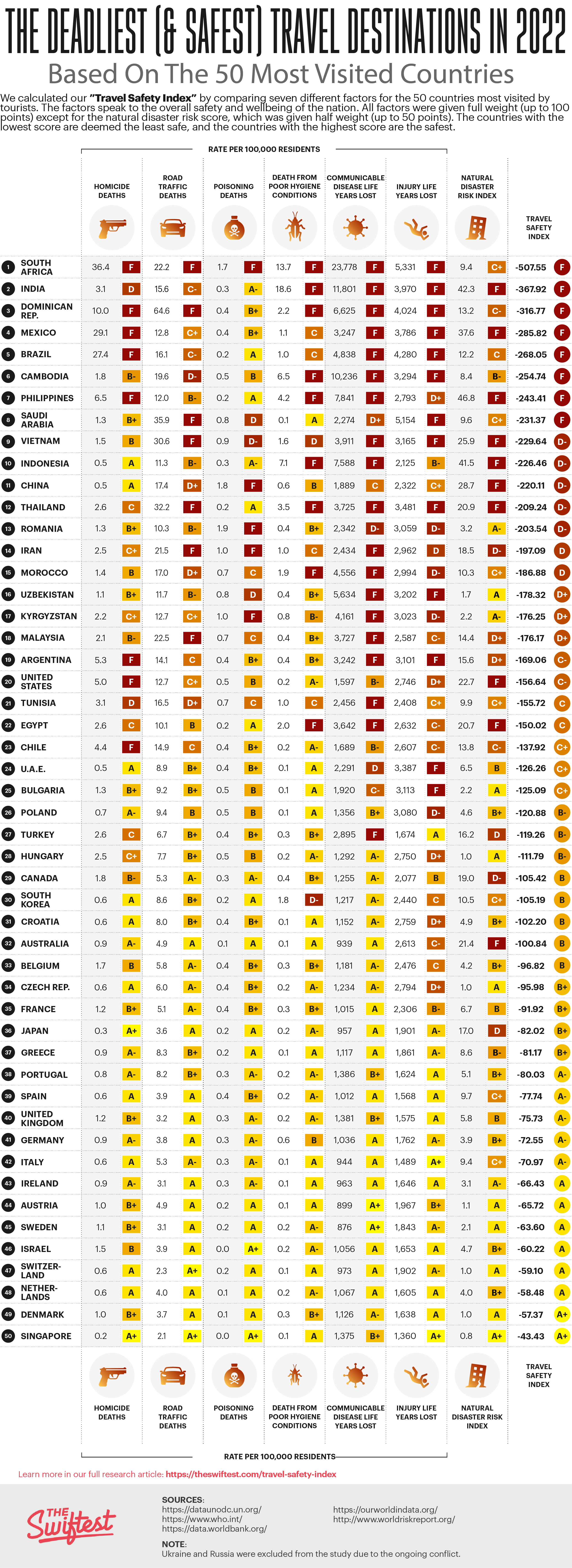
Get notified when we publish new research studies
Stay in the loop with our cutting-edge data analyses
Ranking Factors
The 50 countries included in our study were selected based on how popular they are among tourists. To determine the deadliest places in the world for tourists, we looked at the following ranking factors:
Please note: Due to ongoing conflicts in the region, Russia and Ukraine were omitted from the study.
1. Homicide Rate (0-100 points) – The number of intentional homicides per 100,000 people.
Source: United Nations Office on Drugs and Crime
2. Road Traffic Death Rate (0-100 points) – The estimated road traffic death rate per 100,000 people.
Source: World Health Organization
3. Poisoning Death Rate (0-100 points) – The mortality rate attributed to unintentional poisonings per 100,000 people.
Source: World Health Organization
4. Unsanitary Conditions Mortality Rate (0-100 points) – The mortality rate that is attributed to unsafe sanitation, unsafe water, and a lack of proper hygiene per 100,000 people.
Source: World Bank
5. Life Years Lost Due to Communicable Diseases (0-100 points) – The number of life years lost due to infectious diseases (adjusted for disabilities) per 100,000 people.
Source: Our World in Data
6. Life Years Lost Due to Injury (0-100 points) – Age-standardized and disability-adjusted life years lost due to injuries (including conflict, violence, and self-harm) per 100,000 people.
Source: Our World in Data
7. Natural Disaster Risk (0-50 points) – An index created by the German non-profit Bündnis Entwicklung Hilft in partnership with the United Nations University Institute for Environment and Human Security, the World Risk Report scores countries based on the risk of a natural disaster such as earthquakes, floods, or cyclones as well as the ability of the country to handle a disaster should it occur.
Source: WorldRiskReport
Study Limitations
An individual’s exposure to risk while traveling largely depends on the type of travel they choose and which areas of a country they visit. For example, going to a destination and staying in an all-inclusive luxury resort will often carry significantly less risk of bodily harm than staying in an area known for high crime, injury, or natural disasters. It’s impossible to account for every variable that a traveler may experience when analyzing countries as a whole. This study attempts to aggregate data taking into account a variety of factors to determine a nations overall risk profile.
Where Are the Most Dangerous Places to Travel?
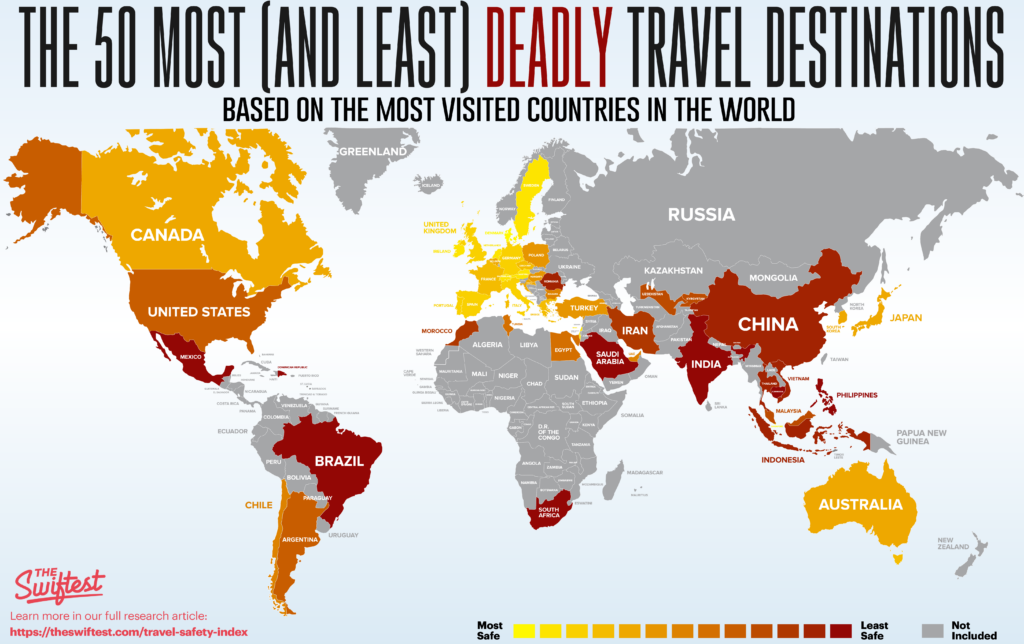
Below are the 20 deadliest travel destinations:
- South Africa
- India
- Dominican Republic
- Mexico
- Brazil
- Cambodia
- Philippines
- Saudi Arabia
- Vietnam
- Indonesia
- China
- Thailand
- Romania
- Iran
- Morocco
- Uzbekistan
- Kyrgyzstan
- Malaysia
- Argentina
- United States
#1 Most Deadly Country: South Africa

South Africa is a beautiful and exceptionally biodiverse country that attract millions of international tourist each year. However, it also tops the list of the most deadly countries for tourists. Out of the 50 countries studied, South Africa has the highest homicide rate (36.40 per 100,000 people) and the highest number of life years lost due to communicable diseases (23,778 years per 100,000 people). The country also has the sixth-highest road traffic death rate (22.22 per 100,000 people).
South Africa scored an F in six of the seven factors used in our research study. The U.S. Department of State indicates:
“Violent crime, such as armed robbery, rape, carjacking, mugging, and ‘smash-and-grab’ attacks on vehicles, is common. There is a higher risk of violent crime in the central business districts of major cities after dark.
Demonstrations, protests, and strikes occur frequently. These can develop quickly without prior notification, often interrupting traffic, transportation, and other services; such events have the potential to turn violent.”
Why is South Africa so unsafe?
Approximately 68 people are murdered in South Africa every day. Why this occurs is a complicated question to answer, but many believe it boils down to the following reasons:
- Poverty and income inequality
- High amounts of gang violence and organized crime
- Weak, slow judicial system
Other factors like the prevalence of easy access to firearms, alcohol abuse, unemployment, and corruption have also been cited as causes for the extremely dangerous crime and hazardous living conditions within South Africa.
#2 Most Deadly Country: India

India is second on the list of most deadly countries for tourists. While the country has a relatively low homicide rate and poisoning death rate, they are the top country for deaths from poor hygiene conditions, at 18.6 per 100,000 people.
Not only is India extremely populated, but it is also has extreme income inequality, with a massive gap between the country’s richest and poorest citizens. This wealth gap means that many of India’s over 1.3 billion people live in poverty and dangerous living conditions, with an estimated 60% of its citizens surviving on little over $3 a day.
Shoddy infrastructure, substandard health, and sanitation conditions are just some of the issues that Indians face on a daily basis, with the lowest classes being forced to navigate the worst of it.
Most and least deadly by category
Homicides
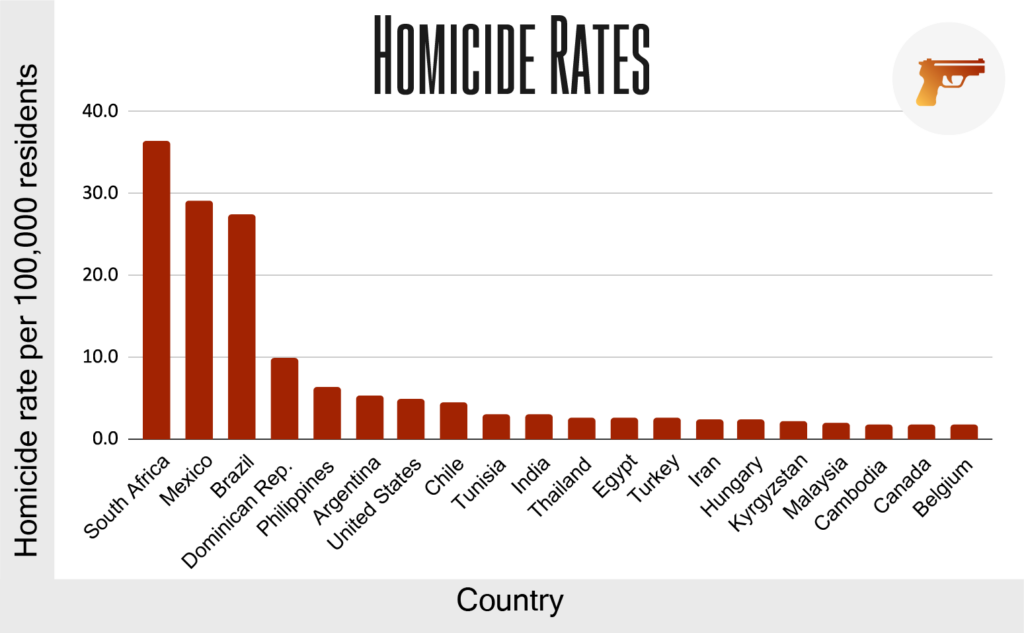
South Africa has the most documented incidents of homicide by a relatively large margin, with 36.4 homicides per 100,000. Mexico, the country with the second highest homicide rate, has 29.1 homicides per 100,000, and Brazil has 27.4 homicides per 100,000. The homicide rate drops significantly from there, with the remaining countries reporting 10.00 or fewer per 100,000. Notably, the US has the 7th highest rate of homicide when compared to these 50 countries.
The countries with the highest homicide death rates are:
- South Africa
- Mexico
- Brazil
- Dominican Republic
- Philippines
- Argentina
- United States
- Chile
- Tunisia
- India
Road Deaths
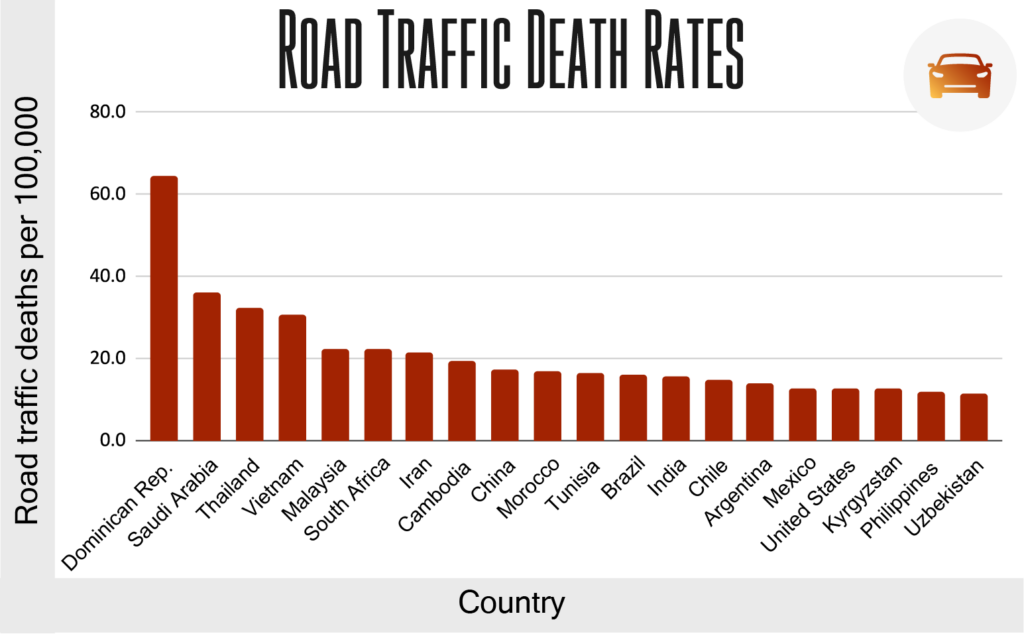
Vehicle transportation is unavoidable for most travelers, and unsafe road conditions can provide a considerable safety hazard in many countries. According to the CDC, 1.35 million people globally are killed in motor vehicle accidents every year, making this a real danger and a serious consideration when traveling to countries with more lax driving laws and poorly maintained infrastructure.
The Dominican Republic has a road death every two hours, which accounts for a significant portion of Dominican Republic deaths per year. Reasons for the dangerous road conditions are attributed to “a lethal mix of alcohol, speed and blatant disregard for traffic laws,” according to The San Diego Union-Tribune.
The countries with the highest road traffic death rates are:
- Dominican Republic
- Saudi Arabia
- Thailand
- Vietnam
- Malaysia
- South Africa
- Iran
- Cambodia
- China
- Morocco
Poisoning Deaths
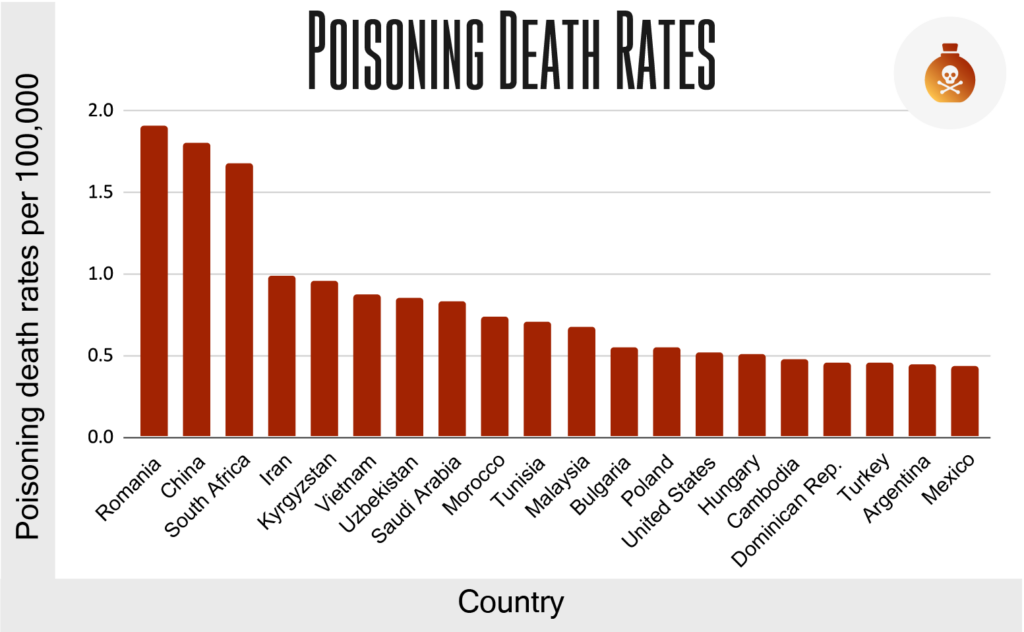
Romania, China, and South Africa are all outliers when it comes to poisoning deaths. According one study by the NIH, China had 16,179 unintentional poisoning deaths in 2016 which made up 31% of the world’s total of 52,077 poisoning deaths that year. The details and causes of poisoning incidents in China is scattered which suggests these numbers may be underreported.
The countries with the highest poisoning death rates are:
- Romania
- China
- South Africa
- Iran
- Kyrgyzstan
- Vietnam
- Uzbekistan
- Saudi Arabia
- Morocco
- Tunisia
Mortality Rate from Unsanitary Conditions
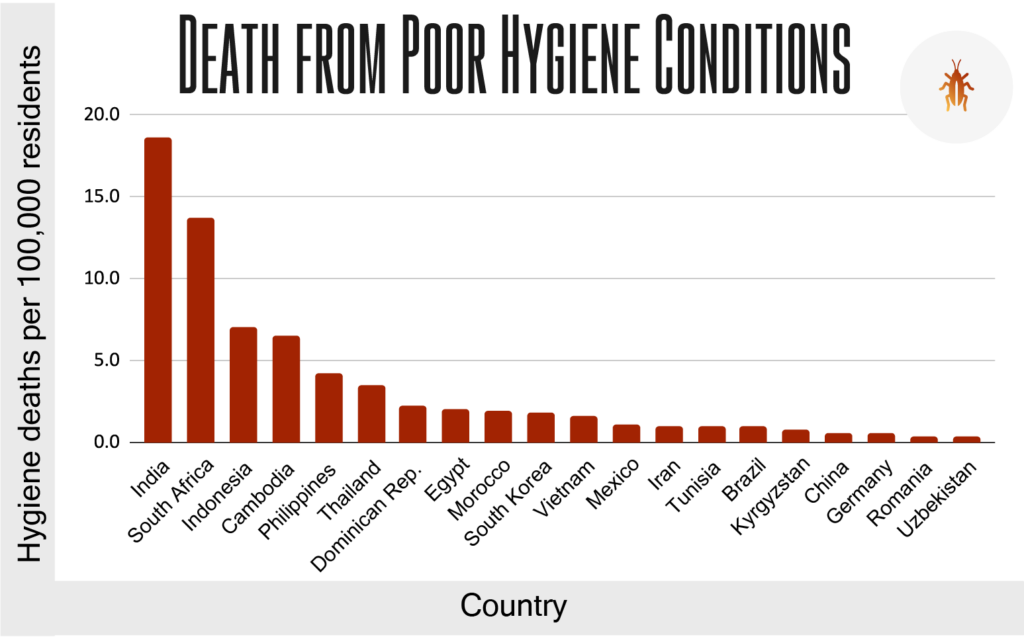
Anyone who has had traveler’s diarrhea or another food-borne illness will know how vital sanitation is when it comes to a vacation. There are ways to prevent illness from unsanitary conditions, but it’s not entirely possible to eradicate the threat of sickness in all regions.
While India is a developing country and is modernizing quickly, there’s still much progress to be made in terms of general hygiene. An estimated one in ten deaths in India is attributed to poor hygiene conditions. Similarly, South Africa is having significant issues with clean water access and available sanitation services for its citizens, though this does appear to be improving.
The countries with the highest death rates from poor hygiene:
- India
- South Africa
- Indonesia
- Cambodia
- Philippines
- Thailand
- Dominican Republic
- Egypt
- Morocco
- South Korea
Communicable Disease Deaths
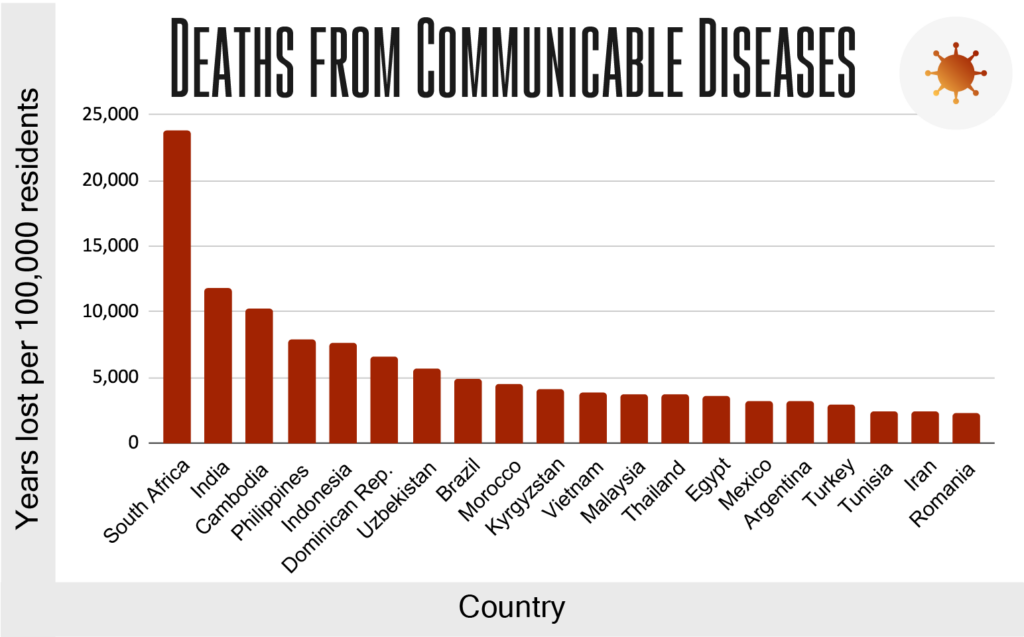
Covid-19 has shown us that infectious diseases are extremely serious, but many other diseases around the world also have devastating impacts and cause countless deaths every year. These include diseases like dengue fever, malaria, measles, cholera, typhoid, yellow fever, and more. It’s always a good idea to check with your medical provider before traveling to a new region because they will have data available to ensure you are immunized against local diseases as much as possible and can take other preventative measures such as wearing insect repellant.
South Africa has over double the number of life years lost due to communicable diseases as India. Some of the diseases affecting South Africans include HIV, tuberculosis, respiratory infections, and more, according to the CDC.
The countries with the highest number of years lost from communicable diseases:
- South Africa
- India
- Cambodia
- Philippines
- Indonesia
- Dominican Republic
- Uzbekistan
- Brazil
- Morocco
- Kyrgyzstan
Life Years Lost to Injury
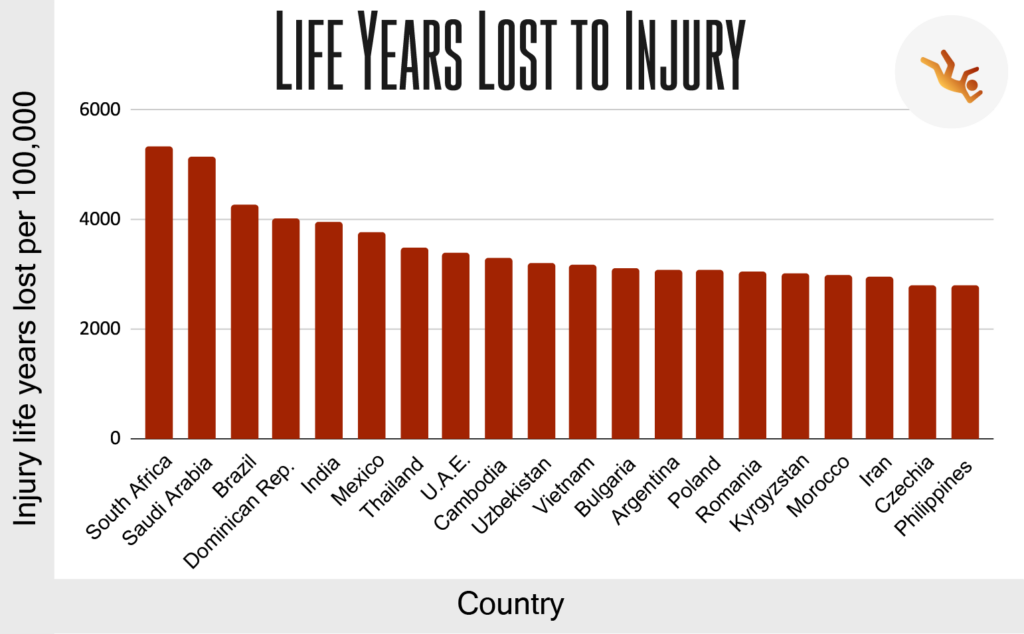
Injury in life is inevitable. You can’t prevent a broken arm or a sprained ankle anywhere in the world, but some regions are more prone to accidents or injury. This can be for various reasons, including infrastructure problems, inaccessible walkways, poorly maintained hiking paths, and much more.
South Africa has the highest years of life lost due to injuries, with many of those injuries coming from interpersonal violence and road traffic incidents. Saudi Arabia likewise reports many injuries, with most reported injuries affecting young males. These injuries were largely traffic-related.
The countries with the highest number of life years lost to injury are:
- South Africa
- Saudi Arabia
- Brazil
- Dominican Republic
- India
- Mexico
- Thailand
- United Arab Emirates
- Cambodia
- Uzbekistan
World Risk Index
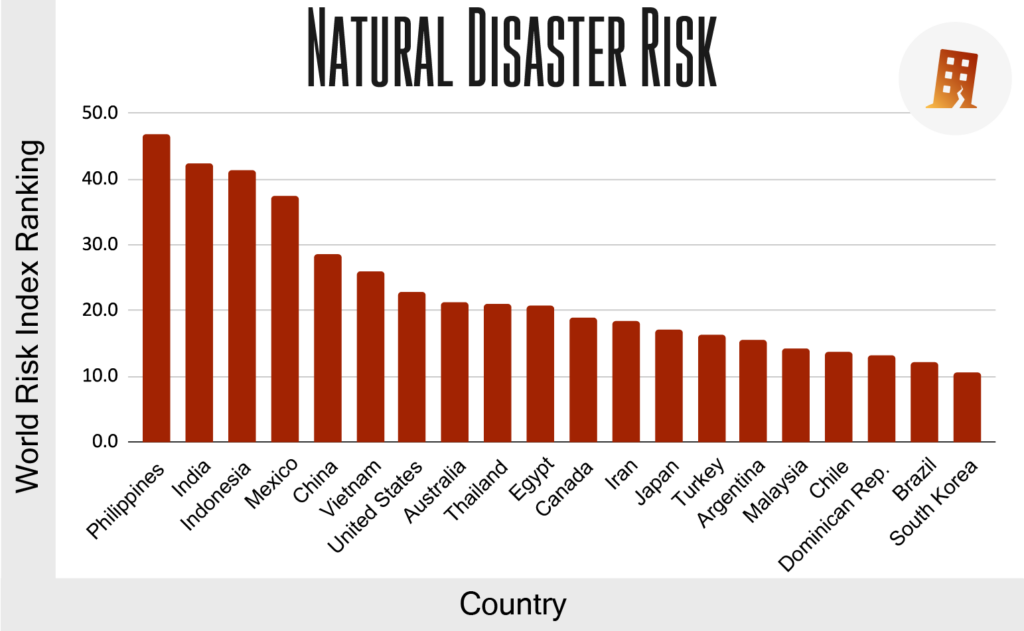
Natural disasters are increasingly becoming a regular part of our modern life due to the impacts of climate change, and it would be unwise to fail to consider the likelihood of natural disasters when picking a travel destination. Not only should the location be factored in, but also the season. For example, many counties have significant and deadly monsoon and hurricane seasons, which can threaten tourists and locals alike.
The most dangerous country when it comes to natural disaster risk and readiness response is the Philippines, according to the annual World Risk Index. The Philippines garnered a score of 46.8. The second and third most dangerous countries are India and Indonesia, followed by Mexico and China. Notably the US and Australia ranked 7th and 8th respectively.
The countries with the highest natural disaster risk:
- Philippines
- India
- Indonesia
- Mexico
- China
- Vietnam
- United States
- Australia
- Thailand
- Egypt
What Are the Safest Countries for Tourists to Visit?
Based on data for 50 of the most-visited countries in the world, these are the fifteen safest countries for tourists and their Travel Safety Index scores:
- Singapore
- Denmark
- Netherlands
- Switzerland
- Israel
- Sweden
- Austria
- Ireland
- Italy
- Germany
- United Kingdom
- Spain
- Portugal
- Greece
- Japan
- France
- Czech Republic
- Belgium
- Australia
- Croatia
#1 Safest Country: Singapore

According to our index, Singapore is the least deadly country for tourists. With a very low homicide rate, road death rate, and natural disaster risk, Singapore is an excellent choice for travelers in terms of safety.
What makes Singapore so safe? Well, crime does not pay in Singapore. The consequences for committing crimes in Singapore are incredibly high, even for “smaller” crimes. This, combined with high surveillance and police presence, makes Singapore the world’s safest country for travel.
This, of course, doesn’t mean you shouldn’t still take universal safety precautions, even in Singapore. For some top travel safety tips, see the end of the article.
#2 Safest Country: Denmark

Denmark’s high safety ranking likely won’t come as a surprise to those familiar with Denmark’s reputation. The low crime rate is often attributed to strong social safety nets that keep its citizens out of poverty, which decreases petty crimes like theft and pickpocketing. Denmark also has a robust police presence, a (relatively) transparent government, and high-quality technological surveillance, which makes Denmark an uncommonly safe place to live and travel.
This level of safety and community trust made Denmark go viral recently when people on social media discovered footage of Danish mothers and fathers leaving their newborns outside to sleep in their strollers while the parents go into shops and cafés. This is a common practice and is often believed to help babies and infants sleep comfortably and develop better immune systems. The idea of trusting the general public with an infant seems like madness in many other parts of the world. This goes to show the level of safety and transparency within Denmark.
Tips for staying safe while traveling, no matter the destination

- Never travel without doing your research – Each destination, from the most to the least deadly, will have its share of challenges and hurdles. Looking up common scams in your destination city or country will help you stay sharp and mindful of dangerous tactics.
- Check the natural disaster risk for your region – Many places around the world, from Louisiana to Mumbai, are more prone to natural disasters at certain times of the year. Knowing if your destination is experiencing monsoon season, hurricane season, extreme heat or cold, and other potentially dangerous natural disasters will keep you and your family stay safe and help you avoid potentially high-risk areas.
- Practice universal safety precautions – Just because you might be in a “safe” country, don’t let your guard down. Crime, unsanitary conditions, and injuries can happen anywhere, and tourists are often targeted everywhere in the world.
- Invest in high-quality safety travel gear – Things like RFID neck wallets, money belts, and sturdy luggage locks will help keep you and your family’s items safe around pickpockets.
- Register your trip with your local embassy – Your government having a way to find you and help remove you from a dangerous situation is incredibly important. If you plan to travel internationally, see if your country has a way to report your trip before embarking on your adventure. The United States has STEP (Smart Traveler Enrollment Program), Canada has Registration of Canadians Abroad, and other countries have equivalent programs for their citizens.
- Save your embassy’s information – Speaking of embassies, know your country’s embassy information before traveling internationally. Whether you write down the embassy phone number and address on a piece of paper or add it to your phone’s cloud service, having a way to access your country’s representative embassy while traveling abroad could be lifesaving in the event of an emergency.
- Travel with a friend or family member – Solo travel can be a fun, freeing activity. But it can also open you up to more potential risks. Traveling with friends and family is often a safer alternative to solo travel.
- Don’t keep all of your cash in one place – Having all your funds in a central location could be disastrous should an emergency arise. If you get robbed, your wallet goes missing, or you get separated from the rest of your group, it’s essential to have emergency money to fall back on. Keeping extra cash in your phone case, in your shoe, or somewhere else inconspicuous may seem silly, but it could bail you out in a pinch.
- Be careful where you eat – Not all countries enforce strict sanitation standards regarding food and beverages. Check reviews, go to restaurants suggested by friends and family, and practice precautions when eating out (particularly when it comes to street food).
- Know the risks of your destination and travel accordingly – If, for example, you do some research and find that your destination may not have the safest water, you can bring a Grayl or filter bottle. Knowing what to expect by planning ahead can save money (and discomfort) during the trip.
- Have your medical information (securely) available – Nobody wants to think about the possibility of hospitalization or injury while on vacation, but it can and does happen. Memorizing your blood type, having a list of your medications and dosages, as well as any allergies and other pertinent medical info available for medical professionals to review is critical should an emergency arise.
- Hire a guide – While guides can’t reasonably protect you from all danger, they can use their local knowledge of the country to keep you safe. Many guides will provide translation services, ensure you eat in safe restaurants, and can help you avoid dangerous neighborhoods.
- Keep a family member or friend aware of your travel plans – Having a friend or family member back home know your travel itinerary could be incredibly helpful if something goes wrong.
- Listen to your intuition – If something doesn’t feel safe, seems too good to be true, or otherwise sets off “alarm bells” while traveling, trust your instincts and remove yourself if it is safe to do so.
- Always travel with insurance – You never know what can happen while traveling. Whether you’re traveling domestically or across the world, it’s always better to err on the side of caution. Travel insurance is often fairly inexpensive (often costing less than $100 for a two-week trip) and can save thousands in emergency expenses. See some of our guides here: Antartica, Belize, Costa Rica, Cruise, Dubai, and Europe.
Sources
- United Nations Office on Drugs and Crime
- World Health Organization
- World Bank
- Our World in Data
- WorldRiskReport
- CNN: Seeing the new India through the eyes of an invisible woman
- Business Tech: New data shows shocking rise in violent crime in South Africa
- CNET: India spent $30 billion to fix its broken sanitation. It ended up with more problems
- The Economist: Why it is so hard to fix India’s sanitation
- Borgen Project: 10 Facts about Sanitation in South Africa
- National Library of Medicine: The high burden of injuries in South Africa
- National Library of Medicine: Burden of traumatic injuries in Saudi Arabia
